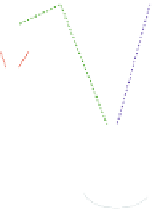Information Technology Reference
In-Depth Information
User 1
User N
...
...
Job1
Job2
JobN
LAN/WAN
...
Job1
Job2
JobN
...
Cloud Broker 1
Cloud Broker N
Job Scheduler
Logical,
user-owned
clusters (VMs)
VM Scheduler
Cloud Provider 2
Cloud Provider 1
Physical
machines
Cloud Provider M
Fig. 1.
High-level view of a federated Cloud
2.2
SI Techniques for Cloud Scheduling
Broadly, SI techniques [9] have shown to be useful in optimization problems. The ad-
vantage of these techniques derives from their ability to explore solutions in large search
spaces in a very e
cient way. The most popular SI-based techniques are ACO and PSO.
ACO [9] arises from the way real ants behave in nature, i.e., from the observation of ant
colonies when they search the shortest paths to reach a food source from their nest. In
nature, real ants move randomly from one place to another to search for food, and upon
finding food and returning to their nest each ant leaves a
pheromone
that lures other
working ants to the same course. When more and more ants choose the same path, the
pheromone trail is reinforced and even more ants will further choose it. Over time the
shortest paths will be intensified by the pheromone faster since the ants will both reach
the food source and travel back to their nest at a faster rate.
On the other hand, PSO [9] is a population-based technique that finds solution to
a problem in a search space by modeling and predicting insect social behavior in the
presence of objectives. In the algorithm the general term “particle” is used to represent
birds, bees or any other individuals who exhibit social behavior as group and interact
with each other. An example based on nature to illustrate the algorithm is as follows: a
group of bees flies over the countryside looking for flowers. Their goal is to find as many
flowers as possible. At the beginning, bees do not have knowledge of the field and fly to
random locations with random velocities looking for flowers. Each bee has the capability
of remember the places where it saw the most flowers, and moreover, somehow knows
the places where other bees have found a high density of flowers. These two pieces of
information -
nostalgia
and
social knowledge
- are used by the bees to continually modify
their trajectory, i.e., each bee alters its path between the two directions to fly somewhere
between the two points and find a greater density of flowers. Occasionally, a bee may
fly over a place with more flowers than any other place found previously by other bees
in the swarm. If this happens the whole swarm is attracted towards this new direction.













































































































































































































































